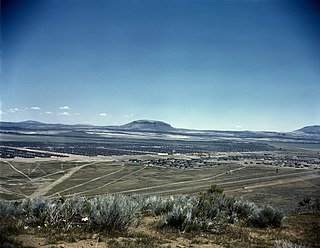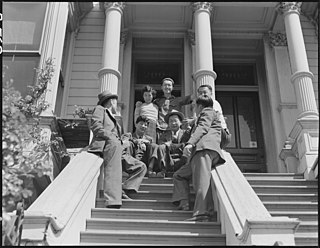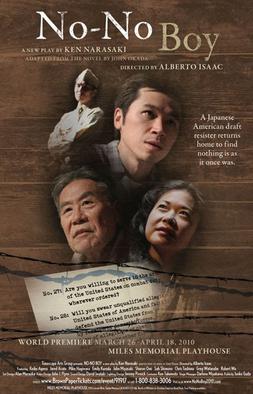
During World War II, the United States, by order of President Franklin D. Roosevelt, forcibly relocated and incarcerated at least 125,284 people of Japanese descent in 75 identified incarceration sites. Most lived on the Pacific Coast, in concentration camps in the western interior of the country. Approximately two-thirds of the inmates were United States citizens. These actions were initiated by Executive Order 9066 following Imperial Japan's attack on Pearl Harbor. Of the 127,000 Japanese Americans who were living in the continental United States at the time of the Pearl Harbor attack, 112,000 resided on the West Coast. About 80,000 were Nisei and Sansei. The rest were Issei immigrants born in Japan who were ineligible for U.S. citizenship under U.S. law.

The War Relocation Authority (WRA) was a United States government agency established to handle the internment of Japanese Americans during World War II. It also operated the Fort Ontario Emergency Refugee Shelter in Oswego, New York, which was the only refugee camp set up in the United States for refugees from Europe. The agency was created by Executive Order 9102 on March 18, 1942, by President Franklin D. Roosevelt, and was terminated June 26, 1946, by order of President Harry S. Truman.
John Okada was a Japanese American novelist known for his critically acclaimed novel No-No Boy.

The Heart Mountain War Relocation Center, named after nearby Heart Mountain and located midway between the northwest Wyoming towns of Cody and Powell, was one of ten concentration camps used for the internment of Japanese Americans evicted during World War II from their local communities in the West Coast Exclusion Zone by the executive order of President Franklin Roosevelt.

The Tule Lake National Monument in Modoc and Siskiyou counties in California, consists primarily of the site of the Tule Lake War Relocation Center, one of ten concentration camps constructed in 1942 by the United States government to incarcerate Japanese Americans forcibly removed from their homes on the West Coast. They totaled nearly 120,000 people, more than two-thirds of whom were United States citizens. Among the inmates, the notation "鶴嶺湖" was sometimes applied.

Minidoka National Historic Site is a National Historic Site in the western United States. It commemorates the more than 13,000 Japanese Americans who were imprisoned at the Minidoka War Relocation Center during the Second World War. Among the inmates, the notation 峰土香 or 峯土香 was sometimes applied.

The Amache National Historic Site, formally the Granada War Relocation Center but known to the internees as Camp Amache, was a concentration camp for Japanese Americans in Prowers County, Colorado. Following the Japanese attack on Pearl Harbor on December 7, 1941, Japanese Americans on the West Coast were rounded up and sent to remote camps. Among the inmates, the notation "亜町" was sometimes applied.

The Topaz War Relocation Center, also known as the Central Utah Relocation Center (Topaz) and briefly as the Abraham Relocation Center, was an American concentration camp that housed Americans of Japanese descent and immigrants who had come to the United States from Japan, called Nikkei. President Franklin Roosevelt signed Executive Order 9066 in February 1942, ordering people of Japanese ancestry to be incarcerated in what were euphemistically called "relocation centers" like Topaz during World War II. Most of the people incarcerated at Topaz came from the Tanforan Assembly Center and previously lived in the San Francisco Bay Area. The camp was opened in September 1942 and closed in October 1945.

The Poston Internment Camp, located in Yuma County in southwestern Arizona, was the largest of the 10 American concentration camps operated by the War Relocation Authority during World War II.

Mike Masaru Masaoka was a Japanese-American lobbyist, author, and spokesman. He worked with the Japanese American Citizens League for over 30 years. He was a key player in encouraging cooperation of the JACL with Japanese American internment during World War II, but also fought for rights of Japanese-Americans during and after the war.

The Jerome War Relocation Center was a Japanese American internment camp located in southeastern Arkansas, near the town of Jerome in the Arkansas Delta. Open from October 6, 1942, until June 30, 1944, it was the last American concentration camp to open and the first to close. At one point it held as many as 8,497 detainees. After closing, it was converted into a holding camp for German prisoners of war. Today, few remains of the camp are visible, as the wooden buildings were taken down. The smokestack from the hospital incinerator still stands.

The Rohwer War Relocation Center was a World War II Japanese American concentration camp located in rural southeastern Arkansas, in Desha County. It was in operation from September 18, 1942, until November 30, 1945, and held as many as 8,475 Japanese Americans forcibly evacuated from California. Among the inmates, the notation "朗和" was sometimes applied. The Rohwer War Relocation Center Cemetery is located here, and was declared a National Historic Landmark in 1992.
Hiroshi Kashiwagi was a Nisei poet, playwright and actor. For his writing and performance work on stage he is considered an early pioneer of Asian American theatre.

No-No Boy (2010) is a play written by Ken Narasaki adapted from the novel of the same title by John Okada, originally produced at the Miles Memorial Playhouse in Santa Monica, California, in association with Timescape Arts Group. It is a drama in two acts. The play was directed by Alberto Isaac, and received its world premiere on Saturday, March 27, 2010. The story follows a Japanese American World War II draft resister as he returns home from prison, in 1946.
99 Years of Love 〜Japanese Americans〜 is a five-episode Japanese-language TV miniseries produced by TBS for its 60th anniversary announced in 3–7 November 2010, starring Tsuyoshi Kusanagi and Yukie Nakama, and sponsored by Toyota and Panasonic.
Frank Seishi Emi was a Japanese American civil rights activist. He was a leading figure of the Heart Mountain Fair Play Committee, an ad hoc group who protested the drafting of Japanese Americans interned during World War II. Emi argued it was unconstitutional to conscript men who had been stripped of their civil rights into military service and advised Nisei who received draft orders to demand they be released from camp before reporting for duty. He was convicted of conspiring to violate the Selective Service Act and served eighteen months of a four-year sentence in federal prison. For many years, Emi and his fellow draft resisters were condemned as troublemakers by the Japanese American Citizens League and the larger Japanese American community, but his legacy has more recently come to be seen as an important example of civil disobedience.
The Heart Mountain Fair Play Committee was a group organized in 1943 to protest the draft of Nisei, from Japanese American concentration camps during World War II. Kiyoshi Okamoto formed a "Fair Play Committee of One" in response to the War Relocation Authority's controversial loyalty questionnaire in 1943, and was later joined by Frank Emi and other inmates of the Heart Mountain camp. With seven older leaders at its core, the Committee's membership grew as draft notices began to arrive in camp. To challenge their forced "evacuation" by the government, they refused to volunteer or participate in the draft, but the Committee required its members to be citizens loyal to the United States willing to serve if their rights were restored. By June 1944, several dozen young men had been arrested and charged by the U.S. government with felony draft evasion. While the camp at Poston, Arizona produced the largest group of draft resisters, at 106, the Fair Play Committee was the most prominent inmate organization to protest the draft, and the rate of draft resistance at Heart Mountain was the highest of any camp. The number of resisters eventually numbered nearly 300 from all ten camps.
Taneyuki “Dan” Harada was a Japanese-American painter and computer scientist who was incarcerated at Tanforan Assembly Center, Topaz War Relocation Center, Leupp Isolation Center, and Tule Lake Segregation Center during World War II. His paintings capture the experience of Japanese-Americans in concentration camp life, including the segregation, isolation, and discrimination they faced. He learned to paint at various art schools while detained, and continued studying at the California College of Arts and Crafts in Oakland, California after being released at the end of the war. He was the recipient of the James D. Phelan Art Award, established to recognize the achievements of California-born artists across many disciplines, in 1949. Today, pieces of his collections are held at the San Francisco Fine Art Museum, the Autry Museum of Western Heritage, and the Los Angeles County Museum of Art













